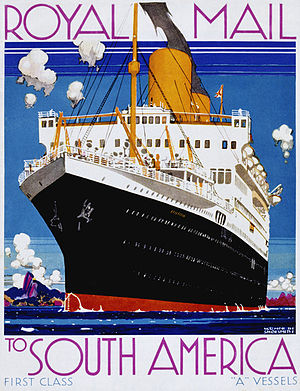RMS Asturias (1925)

RML poster of Asturias with her funnels raised in height after she was rebuilt as a turbine steamship.
Painting by Kenneth Shoesmith. |
|
| History | |
|---|---|
|
|
|
| Name: |
|
| Namesake: | Principality of Asturias |
| Owner: |
|
| Operator: |
|
| Port of registry: |
|
| Route: | Southampton – South America |
| Builder: | Harland & Wolff, Belfast |
| Yard number: | 507 |
| Launched: | 7 July 1925 |
| Sponsored by: | Rosalind Hamilton, Duchess of Abercorn |
| Completed: | 6 February 1926 |
| Identification: |
|
| General characteristics | |
| Type: |
|
| Tonnage: | |
| Length: | 630 ft 6 in (192.18 m) |
| Beam: | 78 ft 6 in (23.93 m) |
| Draught: | 44 ft 9 in (13.64 m) |
| Depth: | 40 ft 6 in (12.34 m) |
| Decks: | 7 |
| Installed power: | As built: 3,366 NHP; 10,000 ihp, 7,500 bhp |
| Propulsion: |
|
| Speed: |
|
| Boats & landing craft carried: |
built with 30 lifeboats, later reduced to 28 |
| Sensors and processing systems: |
|
| Armament: |
|
| Notes: | sister ship: RMS Alcantara |
RMS Asturias was a Royal Mail Lines ocean liner that was built in Belfast in 1925. She served in the Second World War as an armed merchant cruiser until she was crippled by a torpedo in 1943. She was out of action until 1948 when she returned to civilian service as an emigrant ship. She became a troop ship in 1954 and was scrapped in 1957.
In the First World War the Royal Mail Steam Packet Company lost a number of ships to enemy action, including three of its "A-series" passenger liners: Alcantara, Aragon and Asturias. After the 1918 Armistice RMSP prioritised the replacement of lost cargo ships, using new refrigerated cargo ships to take a share of the growing trade in frozen meat from South America to the UK.
High demand for new merchant ships to replace First World War losses kept shipbuilding prices high, so RMSP Chairman Lord Kylsant deferred ordering any new passenger liners for a few years. However, in 1921 Parliament passed the Trade Facilities Act, which offered low-interest loans and Government guarantees for repayment. In 1924 Kylsant took advantage of the Act by ordering from Harland and Wolff of Belfast a pair of 22,200 GRT passenger liners with a speed of 18 to 19 knots (33 to 35 km/h).
Harland and Wolff launched Asturias on 7 July 1925 and completed her in February 1926. Her sister ship Alcantara was launched on 23 September 1926 and completed in February 1927.Asturias was named after Royal Mail Lines' previous Asturias, which had been a hospital ship in the First World War, survived being torpedoed in 1917 and then after returning to RMSP service after the war had been converted into the cruise ship Arcadian.
...
Wikipedia
